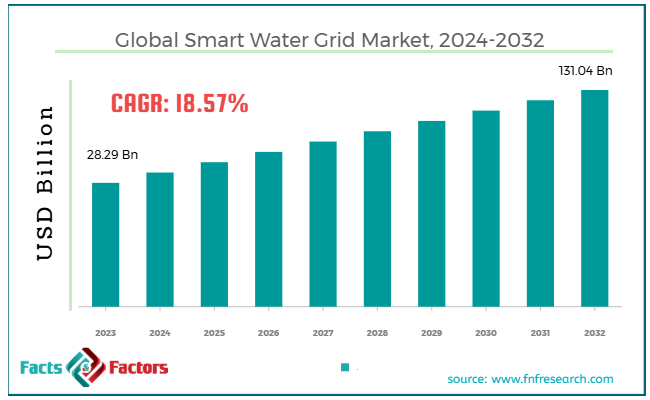Search Market Research Report
Smart Water Grid Market Size, Share Global Analysis Report, 2024 – 2032

Smart Water Grid Market Size, Share, Growth Analysis Report By Product (Smart Infrastructure, Control & Automation, ICT & Analytical Software, Design & Engineering), By Application (Residential, Commercial, Utility), And By Region - Global Industry Insights, Overview, Comprehensive Analysis, Trends, Statistical Research, Market Intelligence, Historical Data and Forecast 2024 – 2032
Industry Insights
[218+ Pages Report] According to Facts & Factors, the global smart water grid market size was worth around USD 28.29 billion in 2023 and is predicted to grow to around USD 131.04 billion by 2032, with a compound annual growth rate (CAGR) of roughly 18.57% between 2024 and 2032.

 Market Overview
Market Overview
A smart water grid is a technologically improved system that uses sensors and digital technology to monitor, optimize, and manage water distribution. It incorporates automation, real-time data, and analytics to reduce wastage, enhance water use, and maximize system reliability. These grids can efficiently identify leaks, manage demand, and track water quality while ensuring sustainable use of water resources and offering better customer service.
The global smart water grid market is witnessing notable progress owing to rising water scarcity concerns, aging infrastructure, and supportive government regulations. Several regions across the globe are experiencing water scarcity issues. Smart water grids resolve these issues by offering enhanced resource management and decreasing water wastage.
Moreover, a key section of water infrastructure is prone to inefficiency, high maintenance costs, leaks, and aging. Smart grids enable utilities to detect and monitor issues while enhancing the lifespan and overall performance of the system. Furthermore, governments are also actively backing the use of smart water grids to enhance water management.
Nonetheless, the global market is restrained by factors like high initial costs and security and data privacy issues. The initial investment for installing data analytics platforms, communication systems, and sensors could be high. This could prevent small businesses and budget-constrained regions from its adoption.
Also, smart water grids gather and share massive quantities of data, thus increasing concerns over data security and privacy. Unauthorized access to water systems may result in misuse of vital data.
Yet, the market is opportune to the rising demand for sustainable solutions and growing urbanization. The rising awareness of environmental problems is shifting interest toward ecology in the water sector. Smart water grids offer better solutions that improve resource management and water conservation and comply with global sustainability objectives.
Moreover, the growing urbanization in several regions is driving the demand for effective water management, thus impacting industry growth.
 Key Insights:
Key Insights:
- As per the analysis shared by our research analyst, the global smart water grid market is estimated to grow annually at a CAGR of around 18.57% over the forecast period (2024-2032)
- In terms of revenue, the global smart water grid market size was valued at around USD 28.29 billion in 2023 and is projected to reach USD 131.04 billion by 2032.
- The smart water grid market is projected to grow significantly due to the growing need for effective water management systems to fight water scarcity, reduce costs, and enhance operational efficiency.
- Based on product, the control & automation segment is expected to lead the market, while the ICT & analytical software segment is expected to register considerable growth in the coming years.
- Based on application, the utility segment is the dominating segment, while the residential segment is projected to witness sizeable revenue over the forecast period.
- Based on region, North America is projected to dominate the global market during the estimated period, followed by Asia Pacific.
 Growth Drivers
Growth Drivers
- Technological improvements in AI and IoT spur the smart water grid market growth
The incorporation of artificial intelligence and the Internet of Things into smart water grid systems allows data collection, analysis, and monitoring in real-time. This streamlines the process of detecting water leaks, automates water distribution, and enhances demand forecasting. These solutions are crucial for minimizing wastage and optimizing water usage.
The worldwide artificial intelligence in the water industry is projected to progress at a notable CAGR of 13.9%, denoting the rising significance of AI in managing water.
An experimental project by South East Water, based in Australia, comprises the installation of 1 million smart water meters that utilize IoT-based sensors to detect leaks and monitor water use. This project is dedicated to boosting customer satisfaction and saving water by offering more precise use of data.
- Water conservation efforts and scarcity majorly fuel the market growth
The rising issue of water scarcity, intensified by overuse and climate change, is driving governments and utilities to adopt more efficient and sustainable water management solutions. Smart water grid systems are vital for identifying early leaks, reducing wastage, and promising equal water distribution.
As per the World Resources Institute, almost 1/4th of the universal population resides in regions experiencing water scarcity and associated issues. This majorly emphasizes the demand for improved water management technologies, such as smart grids.
Singapore has long been a leader in conserving water, with its (Public Utilities Board) PUB adopting smart water grid solutions to minimize wastage and enhance water distribution. The nation has set various goals to emerge as a home for smart water solutions.
 Restraints
Restraints
- Low consumer awareness and acceptance adversely impact the smart water grid market
A majority of consumers lack awareness about the advantages of smart water grids, like cost savings, leak detection, and real-time monitoring. This results in resistance, mainly when users are familiar with the conventional systeq1`ms. This eventually hampers the growth of the smart water grid market.
In India, smart water meter initiatives and projects are witnessing resistance in some regions, where users are worried about the perceived insensitivity of real-time monitoring. This results in delays in installation under several smart city initiatives.
 Opportunities
Opportunities
- Growing demand for water conservation systems impacts the smart water grid market growth
The growing responsiveness to water scarcity is significantly driving businesses, governments, and users to adopt water solutions for enhanced resource management. These solutions offer prospects to enhance water conservation initiatives and meet sustainability objectives.
The World Resource Institute has stated that almost 25% of the worldwide population witnessed high levels of water issues. This creates a progressing industry for smart water technologies. The smart water grid market is projected to substantially reduce water usage by 30% in a few regions.
Californian government has imposed ambitious goals for water conservation, thus boosting the use of real-time monitoring systems and smart water meters to enhance water efficiency in agricultural and urban areas.
- Improvements in monitoring and leak detection technologies to fuel the global market
The development of improved leak detection systems, enabled by AI and IoT sensors, offers a notable opportunity to decrease water loss, a growing vital issue in the key regions.
As per statistics, NRW or non-revenue water is projected to hold nearly 25-30% of water distributed on a global scale, with a few regions witnessing higher issues. Adopting smart leak detection solutions can majorly reduce non-revenue water by nearly 15% in the coming decade.
The United Kingdom's United Utilities is heavily spending on improved leak detection systems that use IoT-based sensors to improve the overall efficiency of the distribution system and decrease water wastage.
 Challenges
Challenges
- Integration challenges with the existing infrastructure restrict the growth of the smart water grid market
Several cities have old-fashioned water distribution systems that are not made for incorporating with the newer systems. Replacing or retrofitting legacy systems can be costly, complex, and time-consuming.
London’s Thames Water is experiencing integration issues as it is looking forward to improving its water distribution technology. Replacing its current infrastructure with modernized IoT sensors and smart meters has proven complex and expensive owing to the network complexity.
 Report Scope
Report Scope
Report Attribute |
Details |
Market Size in 2023 |
USD 28.29 Billion |
Projected Market Size in 2032 |
USD 131.04 Billion |
CAGR Growth Rate |
18.57% CAGR |
Base Year |
2023 |
Forecast Years |
2024-2032 |
Key Market Players |
Xylem, Itron, Sensus, Honeywell, Siemens, Cisco Systems, Schneider Electric, Veolia North America, Emerson Electric, Badger Meter, Kamstrup, Aquacue, Landis+Gyr, SUEZ, AquaViva Technologies, and Others. |
Key Segment |
By Product, By Application, and By Region |
Major Regions Covered |
North America, Europe, Asia Pacific, Latin America, and the Middle East &, Africa |
Purchase Options |
Request customized purchase options to meet your research needs. Explore purchase options |
 Segmentation Analysis
Segmentation Analysis
The global smart water grid market is segmented based on product, application, and region.
Based on product, the global smart water grid industry is divided into smart infrastructure, control & automation, ICT & analytical software, and design & engineering. In 2023, the control & automation segment registered the maximum share of the market and is projected to lead over the forecast period as well. The reasons for the segmental growth comprise the increasing demand for automated solutions that can precisely manage water distribution, detect problems like real-time leaks, and optimize pressure. Control systems and automation help water utilities reduce human interference, improve system reliability, and reduce operational expenses. The segment comprises enhanced technologies like real-time monitoring, SCADA, and automated flow control systems.
On the other hand, the ICT & analytical software segment is the second-leading segment owing to its significance in efficiently managing abundant data produced by smart grids.
Based on application, the global smart water grid industry is segmented as residential, commercial, and utility. The utility segment held a substantial share of the market in 2023 and will continue to dominate. Utilities like water distribution companies are the key adopters of smart grid solutions. This is backed by their need to enhance water distribution, manage demand, reduce water waste, and guarantee better resource usage. Smart grids help utilities to monitor the flow of water, maintain system reliability, and improve infrastructure. Since utilities are accountable for managing large-scale networks of water, their use of smart technologies is a key contributor to the industry growth.
Conversely, the residential segment is projected to hold a considerable share of the market owing to the growing adoption of smart water grid solutions as they help in better water management.
 Regional Analysis
Regional Analysis
- North America to witness substantial growth over the forecast period
North America accounts for a considerable share of the global smart water grid market owing to factors like technological improvements, supportive government initiatives, and an increasing adoption rate. Among others, the United States holds a sophisticated infrastructure and is leading in terms of adoption of novel technologies. These comprise data analytics, the Internet of Things, and artificial intelligence in water management.
Overall, North America is heavily investing in modernizing the former water systems with improved solutions to reduce water wastage and enhance efficiency. Moreover, government grants, policies, and regulations in the region support the use of smart water grid systems.
For example, the U.S. Environmental Protection Agency (EPA) strongly promotes smart grid and water conservation initiatives. Furthermore, North America registered nearly 40% of the global market share in 2024 and is projected to continue dominance over the estimated period owing to the speedy adoption of smart, automated systems and smart meters.
Asia Pacific is the second-leading region in the global smart water grid industry owing to the ever-increasing population and speedy urbanization. Several economies in Asia Pacific, like China and India, are witnessing serious water scarcity problems due to climate change and population growth. This is majorly propelling the use of smart water grid technologies to improve sustainable use, reduce waste, and enhance water management. The region is also experiencing speedy urbanization, which increases the demand for effective water management and distribution. Smart water grids are essential for managing these major urban regions efficiently. By 2025, the Asia Pacific region is anticipated to capture over 30% of the global market.
 Competitive Analysis
Competitive Analysis
The global smart water grid market is led by players like:
- Xylem
- Itron
- Sensus
- Honeywell
- Siemens
- Cisco Systems
- Schneider Electric
- Veolia North America
- Emerson Electric
- Badger Meter
- Kamstrup
- Aquacue
- Landis+Gyr
- SUEZ
- AquaViva Technologies
 Key Market Trends
Key Market Trends
- Cloud platforms for data management:
More utilities are actively adopting cloud-enabled solutions for data analysis and storage. Cloud-based platforms enable remote and scalable access to data, allowing utilities to study water use patterns, enhance system efficiency, and predict demand.
- Integration with smart city projects:
Smart water grids are largely incorporated with an increasing number of smart city projects. These systems work in accordance with other smart infrastructure like traffic, smart lighting, and energy systems. This ultimately helps create sustainable and efficient urban environments.
The global smart water grid market is segmented as follows:
 By Product Segment Analysis
By Product Segment Analysis
- Smart Infrastructure
- Control & Automation
- ICT & Analytical Software
- Design & Engineering
 By Application Segment Analysis
By Application Segment Analysis
- Residential
- Commercial
- Utility
 By Regional Segment Analysis
By Regional Segment Analysis
- North America
- The U.S.
- Canada
- Mexico
- Europe
- France
- The UK
- Spain
- Germany
- Italy
- Rest of Europe
- Asia Pacific
- China
- Japan
- India
- Australia
- Southeast Asia
- Rest of Asia Pacific
- The Middle East & Africa
- Saudi Arabia
- UAE
- Egypt
- Kuwait
- South Africa
- Rest of the Middle East & Africa
- Latin America
- Brazil
- Argentina
- Rest of Latin America
Industry Major Market Players
- Xylem
- Itron
- Sensus
- Honeywell
- Siemens
- Cisco Systems
- Schneider Electric
- Veolia North America
- Emerson Electric
- Badger Meter
- Kamstrup
- Aquacue
- Landis+Gyr
- SUEZ
- AquaViva Technologies
Frequently Asked Questions

Copyright © 2024 - 2025, All Rights Reserved, Facts and Factors


